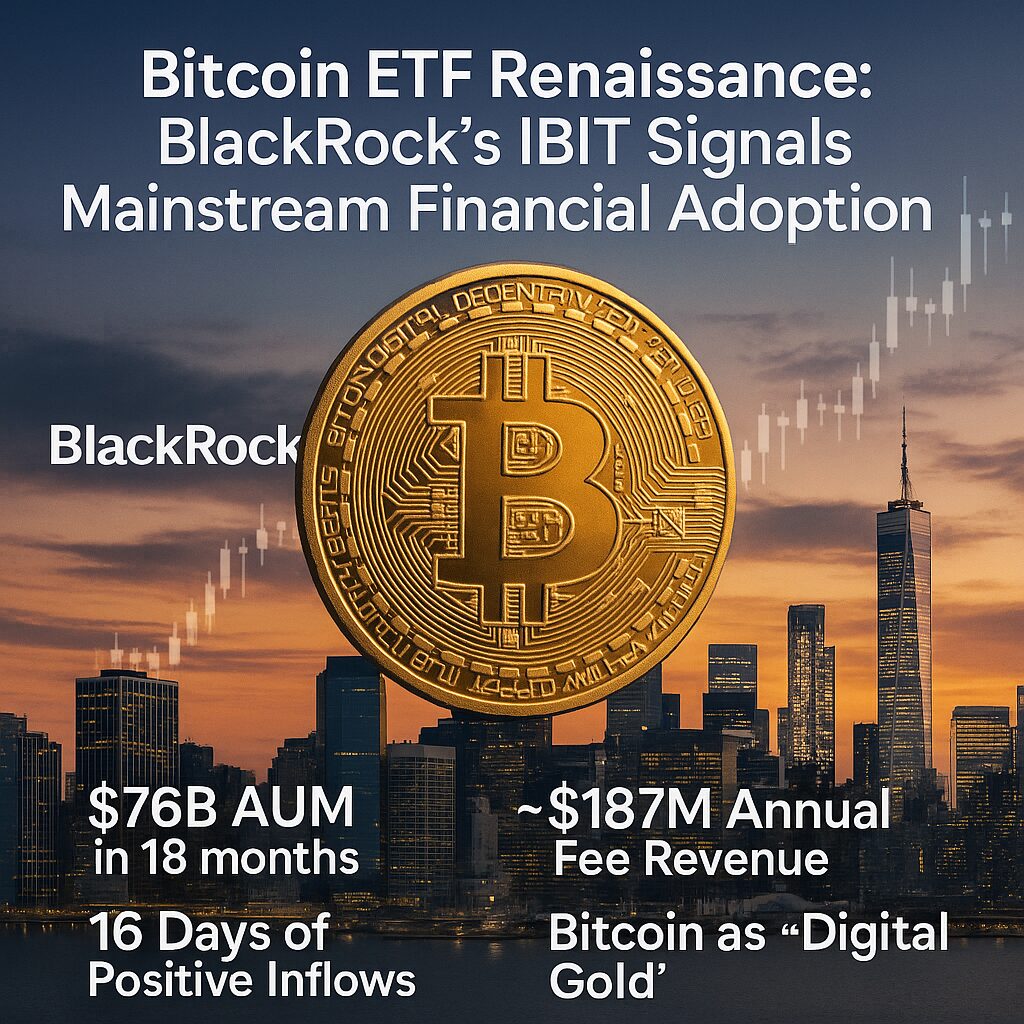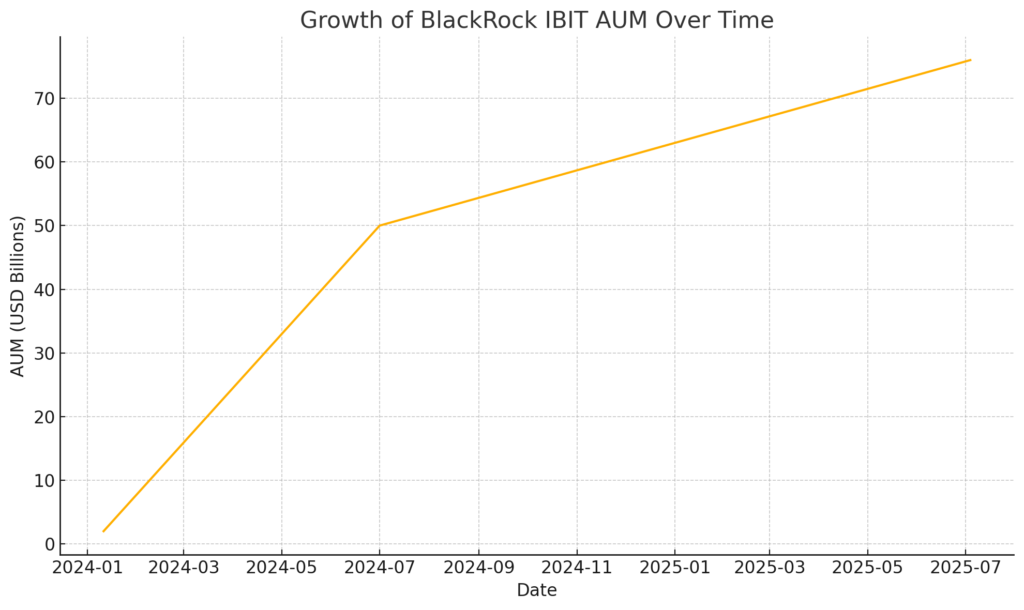
Main Points:
- Unprecedented Growth of IBIT: $76 B AUM in 18 months, fastest for any U.S. ETF.
- Fee Revenue Milestone: Generates ~$187 M annually, surpassing BlackRock’s flagship S&P 500 fund (IVV).
- Record Inflows and Volatility: 16th straight day of positive inflows, offering high option premiums for income strategies.
- Bitcoin as “Digital Gold”: Institutional adoption mirrors the gold ETF evolution over two decades.
- Future Outlook: Regulatory tailwinds and macro factors loom large for ETF momentum.
1. Introduction
Since BlackRock’s iShares Bitcoin Trust ETF (IBIT) began trading in January 2024, it has rewritten expectations for digital-asset products. What started with a historic $2 B inflow in its first days has snowballed into an asset powerhouse, capturing institutional capital at an unprecedented clip. For investors hunting new revenue streams or practical blockchain use cases, IBIT’s trajectory offers a vivid case study in how regulated vehicles can bridge crypto markets and traditional finance.
2. Unprecedented Growth of IBIT
IBIT secured SEC approval and launched in January 2024, swiftly becoming the fastest-growing ETF in U.S. history. Within days, it amassed $2 B, and by July 2024—just six months later—AUM exceeded $50 B. As of July 4, 2025, IBIT holds approximately $76 B of Bitcoin exposure in a fully regulated wrapper, ranking it among the top 5 ETFs by asset size. This rapid scale-up underscores the depth of institutional demand for spot Bitcoin access without custody headaches.
<aside> Below is a chart illustrating IBIT’s AUM growth from launch to July 2025. </aside>

Chart: Growth of BlackRock IBIT AUM Over Time (USD Billions) <!– Chart displayed above via python_user_visible –>
3. Revenue Supremacy: IBIT vs. IVV
Despite being smaller than BlackRock’s iShares Core S&P 500 ETF (IVV), IBIT now generates more fee revenue. With a 0.25% expense ratio on $76 B AUM, annual fees approximate $187 M, edging out IVV’s ~$187.1 M from its 0.03% fee on $624 B AUM. This inversion spotlights the premium investors will pay for regulated Bitcoin exposure and signals that alternative-asset ETFs can rival traditional equity funds in revenue generation.
4. Institutional Inflows and Market Volatility
Bitcoin’s well-known volatility plays to IBIT’s strengths. From June 19 to July 2, Bitcoin ETFs saw 16 consecutive days of net inflows, totaling over $407 M on July 2 alone. IBIT’s share of these flows has been dominant, reflecting trust in BlackRock’s infrastructure. The flipside of volatility is attractive option premiums—traders using covered-call strategies on IBIT can earn annualized returns north of 30% by selling calls into high implied volatility. This dynamic positions IBIT as both a pure-play Bitcoin vehicle and a lever for sophisticated income strategies.
5. Parallels with Gold and Evolution of Digital Gold
The parallels between Bitcoin ETFs and gold ETFs are striking. Over twenty years ago, physically-backed gold ETFs democratized bullion access, driving significant flows and price integration into mainstream portfolios. Today, IBIT is playing that role for Bitcoin, offering a liquid, regulated on-ramp. As ETF adoption grows, Bitcoin’s volatility could moderate, reinforcing its narrative as “digital gold.” Institutional adoption trends—backed by bipartisan regulatory interest such as the GENIUS Act—further legitimize Bitcoin as a strategic diversification tool.
6. Strategic Implications for Investors
For crypto-savvy investors and advisors, IBIT’s performance offers multiple strategic takeaways:
- Core Allocation: A regulated Bitcoin ETF can serve as a core portfolio building block, reducing custody and counterparty risk.
- Income Overlay: High implied vol on IBIT options opens covered-call and cash-secured put strategies for yield enhancement.
- Diversification: Bitcoin’s low correlation to equities and bonds provides a hedge against traditional market drawdowns.
- Cost Considerations: At 0.25%, IBIT’s fee is higher than equity ETFs, requiring conviction in Bitcoin’s long-term thesis to justify expense drag.
7. Looking Ahead: Regulatory and Macro Drivers
The next catalyst for IBIT hinges on regulatory clarity and U.S. monetary policy. A Fed rate cut could rekindle risk-asset rallies, benefitting Bitcoin. Meanwhile, any tightening of ETF rules or changes in SEC oversight will be closely watched. Globally, momentum toward spot Bitcoin ETFs—evident in Europe and parts of Asia—could spur cross-border products and arbitrage opportunities. Active monitoring of policy developments and inflow patterns will be critical for assessing IBIT’s trajectory.
8. Conclusion
BlackRock’s IBIT has transformed the Bitcoin ETF landscape, proving that digital assets can scale in regulated formats at institutional speed. Its record-setting AUM growth, fee revenue milestones, and attraction of income-oriented strategies underscore a maturing market. As Bitcoin continues its march toward mainstream recognition—as “digital gold” and a portfolio diversifier—IBIT stands at the vanguard, offering investors a gateway to blockchain’s practical potential.

